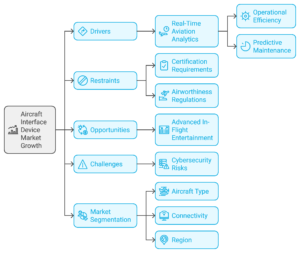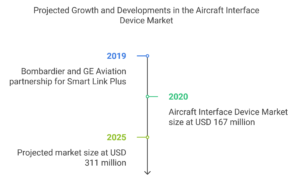In the rapidly evolving aviation sector, technology solutions like Aircraft Interface Devices (AID) play a crucial role in enhancing operational efficiency and connectivity. As real-time analytics and in-flight entertainment gain priority, AIDs serve as the critical hardware enabling seamless data transfer between aircraft avionics and electronic flight bags (EFBs). The global Aircraft Interface Device Market is projected to expand significantly from USD 167 million in 2020 to USD 311 million by 2025, with a strong CAGR of 13.2%. Let’s dive into the fundamentals of AIDs, explore their applications, and examine the factors propelling their market growth.
What is an Aircraft Interface Device?
An Aircraft Interface Device (AID) is a sophisticated avionic component that links aircraft systems with EFBs, inflight entertainment systems, and connectivity solutions. By acting as a central communication hub, AID helps integrate, process, and relay critical data in real time to enhance flight efficiency, safety, and operational management.
How Aircraft Interface Devices Work
Aircraft Interface Devices serve as gateways for various avionics systems to communicate effectively. They use embedded sensors and processors that connect multiple components, like the Flight Management System (FMS) and GPS, to EFBs and other connected devices. AID often relies on both wired and wireless communication methods, facilitating the transmission of data such as:
- Flight plans: Enabling pilots to access and manage real-time navigation updates.
- Engine performance: Relaying critical engine health metrics for monitoring and predictive maintenance.
- Weather updates: Helping flight crews make informed decisions for smoother navigation.
Growth Drivers in the Aircraft Interface Device Market
Several pivotal factors contribute to the growth of the Aircraft Interface Device Industry. Below are some of the main market drivers:
- Rising Demand for Real-Time Aviation Analytics
Real-time analytics is revolutionizing the aviation industry. Airlines benefit from advanced data-driven insights that optimize operational efficiency, safety, and maintenance schedules. AID-enabled analytics improves fuel efficiency, reduces downtime, and minimizes maintenance costs, ultimately enhancing the passenger experience. - Enhanced Situational Awareness for Flight Operations
Situational awareness has become essential for managing operational risks. AIDs offer crucial flight information in real time, empowering pilots with comprehensive, up-to-the-minute data that supports decision-making during flights. - Increasing Demand for In-Flight Connectivity and Entertainment
As passengers increasingly expect entertainment options and Wi-Fi access, the integration of in-flight entertainment and connectivity (IFEC) with AIDs has gained traction. AID technology allows for improved access to movies, games, and shopping, significantly enhancing the passenger experience. - Emergence of Military Applications
The military aviation sector has shown increased interest in AID technology, as it improves situational awareness, mission planning, and real-time information sharing for enhanced combat readiness.
Download PDF Brochure: https://www.marketsandmarkets.com/pdfdownloadNew.asp?id=241873689
Market Opportunities in Aircraft Interface Devices
As the aviation industry becomes more digitally driven, several opportunities have emerged for Aircraft Interface Devices:
- Expansion of In-Flight Entertainment (IFE) Services
Airlines are constantly seeking ways to enhance the passenger experience through IFE options like gaming, e-commerce, and interactive services. The demand for AID technology is expected to grow as airlines invest in IFE upgrades. - Wireless Connectivity Advancements
As wireless solutions become more accessible, AID devices have transitioned from wired to wireless setups, providing greater flexibility. Wireless AID enables better access to real-time data and enhances ground connections, which is crucial for next-generation aircraft. - Technological Innovations in Predictive Maintenance
With advancements in artificial intelligence and machine learning, AID systems are now capable of predictive maintenance, which anticipates potential equipment failures and reduces unscheduled repairs. - Cybersecurity Solutions for AID
The aviation sector’s growing dependence on digital data increases the need for cybersecurity in AID solutions. Addressing cyber threats creates opportunities for companies to develop and integrate secure AID systems, enhancing passenger safety and data protection.
Major Players in the Aircraft Interface Device Market
The Aircraft Interface Device Market is dominated by several Major Players with a strong presence worldwide. Key players include:
- Collins Aerospace (US) Known for its innovations in avionics and connectivity solutions, Collins Aerospace offers comprehensive AID solutions aimed at enhancing operational efficiency and in-flight connectivity.
- Thales SA (France)
Thales specializes in providing data solutions and avionics systems that incorporate advanced cybersecurity measures, ensuring secure communication and data management. - The Boeing Company (US)
Boeing’s extensive knowledge of aircraft manufacturing and avionics gives it an edge in developing integrated AID solutions that improve overall flight performance and connectivity. - Astronics Corporation (US)
Astronics is known for its specialized electronic products that cater to both commercial and military aviation, with a strong focus on innovative AID technology. - Elbit Systems Ltd (Israel)
Elbit provides advanced aerospace solutions, including AID technology with enhanced capabilities for military aircraft, focused on security and combat-readiness.
Recent Developments in the Aircraft Interface Device Market
The industry has seen several noteworthy developments:
- September 2020: Universal Helicopters chose SKYTRAC Systems to streamline crew position and flight reports and improve maintenance tracking on various helicopter models.
- June 2020: Gardner Standard LLC acquired Shadin Avionics, enhancing its position in avionics with AID solutions.
- March 2020: SKYTRAC Systems released “SkyForms” for digitized crew reports, allowing seamless, paper-free data management in real-time.
- February 2020: DAC International joined SKYTRAC’s partner program, expanding its reach in Latin America, Oceania, and Asia for fleet management and data acquisition solutions.
Challenges in the Aircraft Interface Device Market
Despite the numerous opportunities, the market faces challenges:
- Certification and Regulatory Constraints
Certification by regulatory bodies like the FAA and ICAO is required for AID installation. These strict requirements impact the market entry of new players due to the high costs and lengthy approval processes. - Cybersecurity Risks
Wireless AID solutions are more susceptible to cybersecurity threats, making data protection critical. As the industry adopts wireless solutions, securing these networks becomes paramount to maintaining operational safety. - High Cost of Technology Implementation
While AID technology improves flight efficiency, the cost of integration, installation, and maintenance can be prohibitive, particularly for smaller airlines.
Frequently Asked Questions (FAQs)
Q1: What is the growth prospect of the Aircraft Interface Device Market?
The AID market is expected to grow substantially due to rising demand for real-time data and advanced avionics in both commercial and military sectors.
Q2: Which regions are expected to lead in market share?
North America is anticipated to hold the largest market share, driven by high demand from commercial and defense applications.
Q3: How does AID impact in-flight connectivity?
AID enables seamless data transfer, enhancing in-flight entertainment and connectivity for passengers by linking avionics systems with IFE solutions.
Q4: What are the primary applications of AID in military aviation?
Military applications include real-time information sharing, situational awareness, and mission planning, which are vital for defense operations.
Q5: Who are the major players in the AID market?
Collins Aerospace, Thales SA, The Boeing Company, Astronics Corporation, and Elbit Systems Ltd are some of the key players dominating the market.
To Gain Deeper Insights Into This Dynamic Market, Speak to Our Analyst Here: https://www.marketsandmarkets.com/speaktoanalystNew.asp?id=241873689
Key Takeaways
- Market Growth: The Aircraft Interface Device Market is projected to grow from USD 167 million in 2020 to USD 311 million by 2025 at a 13.2% CAGR.
- Primary Drivers: Growth is driven by increased demand for real-time aviation analytics, situational awareness, and in-flight connectivity.
- Challenges: The market faces hurdles in regulatory certification, cybersecurity, and implementation costs.
- Opportunities: Advanced in-flight entertainment options and wireless connectivity present significant growth opportunities.
- Key Players: Collins Aerospace, Thales SA, The Boeing Company, Astronics Corporation, and Elbit Systems Ltd lead the AID market.
This comprehensive look at the Aircraft Interface Device Market offers valuable insights into how these devices are shaping the future of aviation. With real-time analytics, improved connectivity, and enhanced flight safety measures, AIDs are set to become indispensable tools in the aviation industry, driving efficiency, safety, and customer satisfaction.


